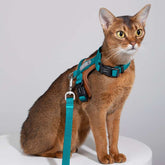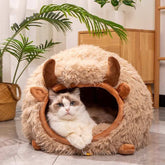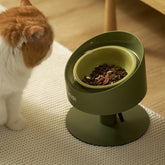Why Fat Cats Aren't Always Cute: Health Risks Explained

Cats. We love them, right? They're our fluffy companions, our unexpected alarm clocks, and sometimes, our little couch potatoes. But let's talk about something that doesn't get enough attention: cat obesity. Sure, a chubby cat might look cute and huggable, but being overweight isn't good for their health. In fact, it can shave years off their lives! So, grab a cup of coffee, and let's dive into why keeping your cat at a healthy weight is one of the best gifts you can give them.
Why Are Fat Cats a Problem?
First things first—what exactly is cat obesity? Simply put, it's when your cat carries too much weight for their size and breed. According to veterinarians, a cat is considered overweight if they exceed their ideal body weight by 10-20%, and obese if they're 20% or more over.
But why does this matter? Because that extra weight doesn't just sit there. It takes a toll on their health. Obesity in cats is linked to a host of serious issues, including:
- Diabetes: Yes, cats can get diabetes too, and obesity is one of the leading causes.
- Arthritis: Extra weight puts additional strain on your cat's joints, which can lead to chronic pain.
- Heart disease: Just like us, carrying too much weight can strain your cat's cardiovascular system.
- Shortened lifespan: Studies show that obese cats live shorter lives than their healthier counterparts.
So while it might be tempting to think your "chonky" kitty is just extra snuggly, the truth is, those extra pounds aren't doing them any favors.
Is My Cat Fat? How to Spot the Signs
It's not always easy to tell if your cat is overweight, especially if they've been steadily gaining weight over time. Here are some quick tips to figure out if your feline friend might be tipping the scales:
- Feel their ribs: Run your hands along your cat's sides. Can you feel their ribs without pressing too hard? If not, they might be carrying extra weight.
- Check their waistline: When looking at your cat from above, you should see a slight inward curve at their waist. No curve? Potential problem.
- Saggy belly: While a pouchy belly (called a primordial pouch) is normal for cats, an overly large one might indicate obesity.
Still not sure? A trip to the vet can give you a definitive answer and help you understand your cat's ideal weight range.

Why Do Cats Get Fat?
Believe it or not, the reasons cats gain weight are pretty similar to ours:
- Overeating: If your cat is eating more calories than they burn, the extra energy is stored as fat.
- Lack of exercise: Indoor cats, while safe from outdoor dangers, often don't get enough physical activity.
- Age: Older cats tend to be less active, which makes weight gain easier.
- Breed: Some breeds, like Maine Coons, are naturally larger, but it's important to distinguish between a big build and excess fat.
And let's not forget the role we play as pet parents. Those extra treats, table scraps, or "free-feeding" habits (leaving food out all day) can quickly add up.
Breed Susceptibility to Obesity
Some cat breeds are naturally more prone to weight gain due to their genetics and body structure. Persian cats, with their laid-back nature and flat faces that can make exercise challenging, are particularly susceptible. British Shorthairs and Ragamuffins are also at higher risk due to their naturally stocky builds and tendency toward a sedentary lifestyle. Even Maine Coons, while naturally large, can become overweight without proper exercise and portion control. Understanding your cat's breed-specific risks can help you take preventive measures early on.

How to Prevent Cat Obesity
Prevention is always better than cure, and the good news is, keeping your cat at a healthy weight isn't rocket science. Here's how to do it:
1. Feed Them Right
Start by choosing a high-quality cat food that's appropriate for their age, size, and activity level. Pay attention to portion sizes—those feeding guidelines on the bag aren't just suggestions. And if you're not sure how much to feed, ask your vet.
Pro Tip: Avoid giving them too many treats, and definitely don't share your human food. As much as your cat might love that piece of cheese, it's not doing their waistline any favors.
2. Keep Them Active
Cats might not need a gym membership, but they do need regular exercise. Invest in toys that encourage movement, like laser pointers, feather wands, or interactive puzzle toys. Even a simple cardboard box can turn into an impromptu jungle gym. Aim for at least 15-20 minutes of playtime a day.
3. Monitor Their Weight
Make weighing your cat a regular habit. You don't need a fancy scale—just weigh yourself, then weigh yourself holding your cat, and subtract the difference. Regular monitoring can help you spot weight gain before it becomes a bigger issue.
4. Don't Free Feed
Instead of leaving food out all day, consider scheduled feedings. This helps control calorie intake and prevents overeating.
5. Consult Your Vet
Your vet is your best ally in keeping your cat healthy. Regular checkups can help catch weight issues early, and they can recommend specific diets or exercise routines tailored to your cat.

What If My Cat Is Already Overweight?
If your cat has already packed on a few extra pounds, don't worry—it's never too late to turn things around. Start by talking to your vet, who can help you develop a safe weight loss plan. This might include:
- Switching to a weight management cat food
- Gradually reducing portion sizes
- Increasing their daily activity
The key here is gradual. Cats can't lose weight as quickly as humans, and rapid weight loss can lead to a dangerous condition called hepatic lipidosis (fatty liver disease). Slow and steady wins the race.
Weight Matters: Your Cat's Path to Wellness
At the end of the day, keeping your cat at a healthy weight isn't just about numbers on a scale—it's about giving them the best possible quality of life. A healthy cat is more active, playful, and likely to live a longer, happier life. And who doesn't want that for their furry best friend?
So the next time you're tempted to give your cat an extra treat or skip playtime, remember: you're not just a pet owner—you're their advocate for a healthy, fulfilling life. And that's worth every effort.

Final Thoughts
While fat cats might dominate memes and internet culture, the reality is far less glamorous. Cat obesity is a serious issue, but it's one we can tackle with small, consistent changes. By focusing on proper nutrition, regular exercise, and a little bit of self-control (no matter how much they beg), you can help your cat stay healthy and thrive for years to come.
Now, go grab those toys and start a fun play session with your cat—their health (and happiness) depends on it!























